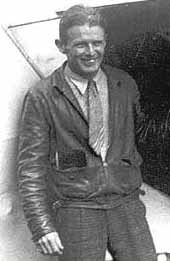Douglas Corrigan
Douglas Corrigan (born January 22, 1907 in Galveston , Texas , † December 9, 1995 in Santa Ana , California ) was an American pilot who was known after a transatlantic flight in 1938 as Wrong Way Corrigan (" Wrong Way Corrigan") has been.
Life
Corrigan was an aircraft mechanic and as an employee of Ryan Aeronautical one of the builders of Charles Lindbergh's airplane Spirit of St. Louis . After Lindbergh's first transatlantic flight, Corrigan also wanted to undertake such a flight; Ireland , the home of his ancestors, was his goal . Since 1933 he flew a Curtiss Robin OX-5. He was considered a daring aviator, and his employer repeatedly forbade him to perform acrobatic maneuvers.
After a 17-hour flight across the North American continent from Long Beach, California to New York City on July 8, 1938, he was supposed to fly back to Long Beach on July 17, 1938. However, he flew towards Europe from Floyd Bennett Field , Brooklyn, and arrived at Baldonnel Airport in the south-west of the Irish capital, Dublin , after 28 hours . He later claimed that a navigation error was to blame for the unauthorized transatlantic flight: thick clouds and difficult lighting conditions had caused him to read his compass incorrectly. However, this representation is not very credible, as he had already made various technical changes to his monoplane in order to prepare it for a transatlantic flight , and between 1935 and 1937 he had already unsuccessfully requested a permit for a non-stop flight to Europe. His "navigational error" was therefore more of a deliberate protest against an administrative bureaucracy that prevented him from fulfilling his great dream. However, Corrigan never publicly admitted that he had flown to Ireland on purpose.
Corrigan and his plane returned to New York by steamboat. Despite breaking numerous laws, he received only a mild sentence: his license to fly was revoked for two weeks. After his return, the New Yorkers celebrated him with a confetti parade , which was attended by more spectators than in the parade after Charles Lindbergh's great triumph. However, Corrigan was disappointed that his great role model Lindbergh did not appreciate his performance.
He quickly became known as the "Wrong Way Corrigan"; this nickname was in the US even as a phrase input in the common parlance. In the year of his flight, he wrote his autobiography That's My Story , which appeared in December 1938. He also brought out merchandising products such as a reverse clock. In 1939 he played himself in the movie The Flying Irishman .
During World War II Corrigan worked as a test pilot for the American military and flew for the US Army Ferry Command. After the war, he was a pilot for a small California airline. In 1946 he ran in California for the conservative Christian Prohibition Party for a seat in the US Senate , but received less than two percent of the vote. In 1950 he settled in Santa Ana and from then on devoted himself to growing oranges. He died there in 1995.
Movie
- The Flying Irishman. 1939 (with Corrigan in the lead role)
Fonts
- That's my story. EP Dutton & Co., New York 1938 / Robert Hale, London 1939.
- Boston's Logan International Airport, gateway to New England. In: Airliners, the world's airline magazine. ISSN 0896-6575 , Vol. 77 (Sept./Oct. 2002), pp. 32-43.
- Foreword to: Walt Bohrer, Ann Bohrer: Tales Up! Aero Publishing, Fallbrook CA 1971, ISBN 0-8168-8800-0 or ISBN 0-8168-8804-3 .
Web links
- The Flying Irishman in the Internet Movie Database (English)
- The Adventures of Wrong-Way Corrigan. by Chris Fasolino (English)
- Front cover of the New York Post (Report on the parade in honor of Corrigan, with an original typographic interpretation of the Wrong Way )
| personal data | |
|---|---|
| SURNAME | Corrigan, Douglas |
| ALTERNATIVE NAMES | Wrong Way Corrigan (nickname) |
| BRIEF DESCRIPTION | American aviation pioneer |
| DATE OF BIRTH | January 22, 1907 |
| PLACE OF BIRTH | Galveston , Texas |
| DATE OF DEATH | December 9, 1995 |
| Place of death | Santa Ana , California |
